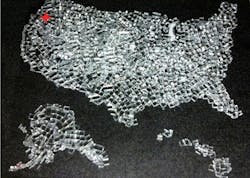FiLaser licenses U of T burst-pulse laser machining patent to improve glass processing
Portland, OR--Laser startup company FiLaser has successfully licensed a key patent from the University of Toronto (U of T; Toronto, ON Canada), effectively enabling it to control so-called Burst-Pulse Laser Machining in the US and Canada. Through a commercial arrangement, FiLaser has negotiated exclusive access to this technology as it relates to the company's approach to cutting and drilling brittle materials such as glass and silicon. "The technique involves some complex, non-linear physics; the commercial arrangement was significantly less complex," said FiLaser CEO, Jeffrey Albelo.
The three-year-old startup can cut glass at thickness up to 6 mm with linear processing speeds up to 1.2 m/s. Based upon picosecond laser engines provided by Coherent, the company has developed an ability to cut the toughest glass out there (like Corning's Gorilla glass), including glass after it has been chemically and thermally tempered—which is unique to the FiLaser process. Portable electronic devices, such as tablets and smart phones require tough substrates in order to stand up to the rigors of daily life. FiLaser says its technology offers today's manufacturers production options previously unavailable. The approach is generic across brittle materials and offers the tantalizing possibility to process sheets of sapphire with similarly stunning results, which could one-day replace chemically tempered glass with the already very scratch-resistant sapphire.
The technique is especially well suited to brittle materials of sufficient transparency to the laser beam. Whether coated or not, on one side or two, chemically or thermally treated, and for LEDs with and without DBR layers, the process robustly produces parts without chipping. Of particular interest have been substrates made from LiNbO3 and LiTaO3, which are notoriously difficult to process using any available technique, but have been processed without defect using the FiLaser process. Albelo added, "There are a number of areas for which the simple application of cutting and shaping silicon, glass and sapphire can be envisioned, but the real value of our technology lies in some of the new manufacturing techniques that we are in the process of developing. Stay tuned, more 'interesting physics' are on the way."
The patent is based upon work conducted by U of T inventors professor Robin Majoribanks and professor Peter Herman, in collaboration with then student Anton Öttl, now leading Qubig GmbH. The invention covers certain time-dependent phenomena associated with so-called burst-pulse laser processing of a variety of substrates and the subsequent modifications of the materials thus processed. It covers a broad swath of technologies encompassing both picosecond and femtosecond laser platforms and laser process solutions. "It is quite likely that anybody utilizing lasers for these types of processes will require a sub-license from FiLaser," noted Portland Intellectual Property Attorney, Mark Hubert, "It really provides them with a key addition to their IP portfolio."
FiLaser is based in Portland, OR and maintains an R&D facility there and in Toronto, ON, Canada. It was founded by Abbas Hosseini, Jung Un Na, and Albelo. The company's approach to brittle materials micromachining is based upon techniques first conceived of by Hosseini, a pioneer in the field of analytical filamentation and the attendant nonlinear laser physics accompanying filament generation.
SOURCE: FiLaser; http://www.filaser.com

Gail Overton | Senior Editor (2004-2020)
Gail has more than 30 years of engineering, marketing, product management, and editorial experience in the photonics and optical communications industry. Before joining the staff at Laser Focus World in 2004, she held many product management and product marketing roles in the fiber-optics industry, most notably at Hughes (El Segundo, CA), GTE Labs (Waltham, MA), Corning (Corning, NY), Photon Kinetics (Beaverton, OR), and Newport Corporation (Irvine, CA). During her marketing career, Gail published articles in WDM Solutions and Sensors magazine and traveled internationally to conduct product and sales training. Gail received her BS degree in physics, with an emphasis in optics, from San Diego State University in San Diego, CA in May 1986.
